Note: This story is one of three on where Idaho’s at-risk students are thriving and what those districts and charters are doing differently. Learn about where those bright spots are, one district’s unique approach to Mondays, and another’s innovative support system for students, teachers, and community members.
IDAHO FALLS – Mondays have gotten a makeover in the Bonneville Joint School District.
The first day of the week is now set aside for catching up, getting help, and planning at the district’s middle and high schools. It seems to be working.
Some of Bonneville’s most at-risk student groups are performing among the best in the state on standardized tests. Likewise, graduation rates are not only among the best but have also shown substantial growth.
Here’s how it works:
- Monday mornings are for students. They get extra help from teachers and come and go to classes as needed, ignoring the bells. For students with Cs or better, attendance is usually optional.
- Monday afternoons are for the teachers. They collaborate with peers and the students head home.
The unique Mondays were a pandemic-era innovation that proved beneficial enough to be kept on the calendar. There are some drawbacks — it’s up to students to get the most out of Mondays, and there’s less teaching time. But surveys show kids and parents are overwhelmingly in favor of continuing the program.
And data seems to show that’s it’s been a worthwhile revamp.
EdNews mined 2022 Idaho Standards Achievement Test data to see where the most at-risk students were performing well, and Bonneville Joint School District was a standout. Its at-risk students outperformed state averages for proficiency in 10 different areas. In five different areas (more than any other district) its at-risk students performed in the top 10 of all districts statewide.
| Student group/subject area | Statewide % of students who scored proficient or better | Bonneville Joint School District % of students who scored proficient or better |
| Limited English proficiency/ELA | 11.9 | 12.5 |
| In foster care/ELA | 28.9 | <65 |
| Experiencing homelessness/ELA | 29.8 | <40 |
| Migrant/ELA | 25.9 | <58 |
| With disabilities/ELA | 15.1 | 18.5 |
| African American/math | 19.1 | 34.9 |
| Migrant/math | 15.7 | <54 |
| In foster care/math | 17.6 | <48 |
| Experiencing homelessness/science | 19.8 | <54 |
| Limited English proficiency/science | <5 | <13 |
*Top ten scores are bolded
And Bonneville’s 2022 four-year graduation rate of 88.3% is among the highest in the state, and above the state average of 79.9%. Its 2022 graduation rate is also nearly 6 percentage points higher than it was in 2019, before the unique schedule was adopted.
| Year | Bonneville’s four-year graduation rate | State average four-year graduation rate |
| 2022 | 88.3 | 79.9 |
| 2021 | 89.6 | 80.1 |
| 2020 | 89.3 | 82.1 |
| 2019 | 82.4 | 80.7 |
“We’ve been very intentional in our efforts to design success for every student,” Bonneville Superintendent Scott Woolstenhulme said.
And the unique approach to Mondays has been a key part of that success. Here’s a closer look at the district’s innovative take on a traditional school week.
The nuts and bolts: how Monday mornings work
On the first two Mondays of a trimester, all students attend. After that, students are notified if they need to attend on Mondays — it’s a requirement for those with Ds or Fs. Those who stay home are provided with ungraded enrichment activities.
Even if students weren’t assigned to attend, they may still do so. They might opt in for academic reasons — to make up a test or a chemistry lab, or get extra help — or if they need supervision, a safe place to be, or provided meals.
And sometimes Advanced Placement or dual enrollment teachers will have all students come on a Monday if they have content they need to cover.
Students can stay in one class all morning if they like, or go to a few others if needed. Once they’re done, they can leave if they have their own transportation. If not, they head to the gym where the physical education teachers take turns supervising the students.
Ultimately, about a quarter to a third of Thunder Ridge High’s students (enrollment is at nearly 1,700) attend each Monday.
At the middle school level, students follow a bell schedule and are given less agency with how to use their time.
An inside glimpse: Monday mornings are for catching up and getting extra help
On a recent Monday morning, students came in and out of Emily Cannon’s Thunder Ridge classroom, some working on math tests or assignments, and others on projects for German (Cannon teaches both subjects). When they hit a roadblock, they raised their hands or brought their work over to Cannon for extra instruction and help.
For Liberty Martinez, a senior, the extra time on Mondays helps her be more successful.
“I can come in and get one-on-one help,” she said. “Without coming in, my grades would probably go down because I’d be behind.”
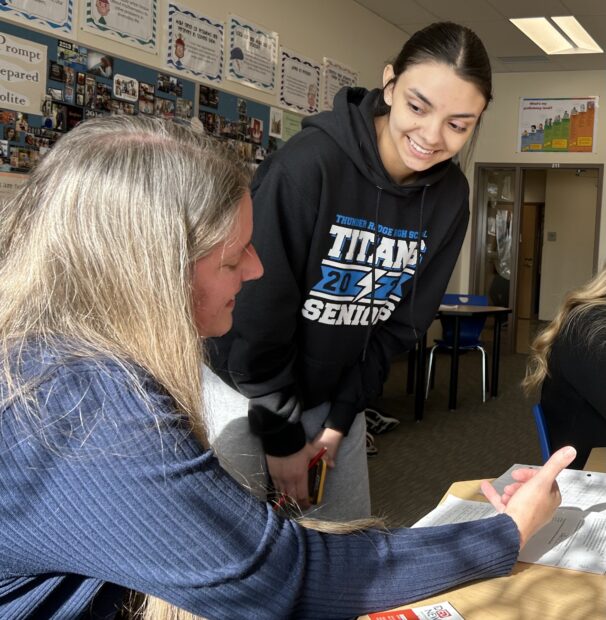
Nearby, a few ninth-graders were working on a project. They said they appreciate being able to come to school on Monday because “you’re in a different mindset when you’re at school compared to when you’re doing things at home.”
About 15 students had filtered through Cannon’s class that Monday morning, working on different assignments.
In another classroom, Lisa Olsen, an English teacher and chair of the English department, always asks her students the same question when they come in: “Do you need help or do you need time?”
And then they get what they need.
Pluses and minuses of the Monday schedule
Admittedly, there are some downsides to the Monday approach.
One critique is the loss of instructional time. Students and teachers are losing one day a week of traditional class time, or 20%.
But after having implemented the unique schedule for nearly three school years – since Fall 2020 – the superintendent, principals, teachers, parents, and students mostly say there are more benefits than losses.
“We have lost instruction time,” Doug McLaren, the principal at Thunder Ridge High School, said. “The tradeoff is helping students that normally might drop out or might not graduate or who are struggling to get through and getting Ds. We’re helping them succeed and hopefully graduate and move on.”
With less instructional time, teachers have had to carefully pare down what they teach and make sure every lesson is essential. At first they had concerns, but now seem to widely favor the Monday schedule.
“Every year we’ve done surveys about this with teachers and parents, and they continue to show really strong support,” Woolstenhulme said.
Woolstenhulme is a parent with three kids in the district himself.
“I really like the schedule because it helps us hold our kids more accountable for getting their work done,” he said.
When his kids are doing well, they are allowed to miss Mondays. But if they fall behind, they’ll be heading to the classroom. And he’s not the only parent who supports the overhauled Mondays.
“We just surveyed kids and parents, and 85% across the board said they’re seeing the benefit,”Jason Lords, the district’s director of instruction and learning, said in December. “It’s been so successful with teachers, kids, and families, that we’ve continued it,” .
The biggest complaint teachers said they’ve heard from parents is about the special schedule being held on Mondays rather than Fridays. But the district has stuck to Mondays because kids are less likely to have mental fatigue and more likely to use the day productively.
Even so, teachers acknowledge that it’s up to students to get the most out of Mondays.
“They definitely have to be proactive enough to take advantage of it,” said Aubrey Brian, an English teacher at Thunder Ridge. “But those students who have learned to see the beauty of it, treat it like a gift and it’s working really, really well for them.”
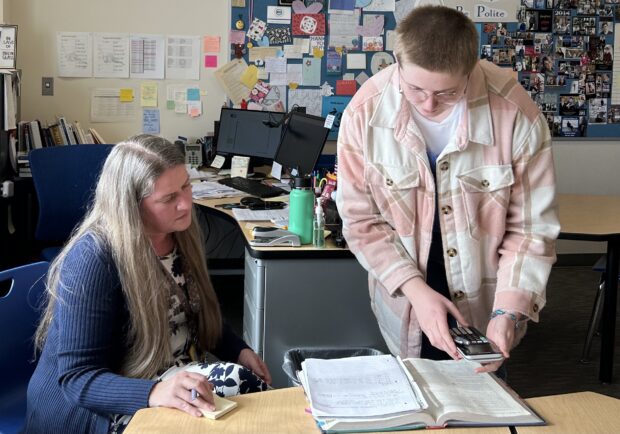
Brian added that the Mondays allow students “more time to develop hobbies and pursue their personal interests and passions,” whether that’s rehearsing with the jazz band or pursuing employment opportunities.
And the Mondays help alleviate anxiety among students, which has been especially paramount after the pandemic.
“The stress management for all students is really beneficial,” Brian said. “And the parents appreciate that too because a lot of parents are at their wit’s end dealing with a mental health crisis. So, it’s a godsend.”
English Teacher KaReena Smith would agree: “It makes a huge difference for students, because they get so overwhelmed,” she said.
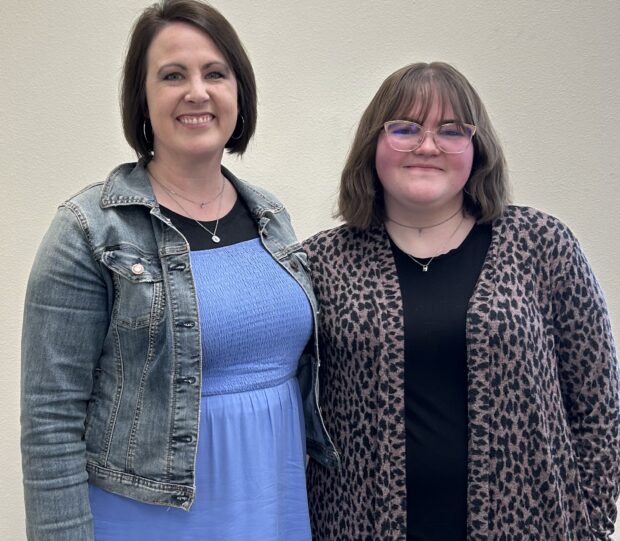
And she said intervention, or getting kids back on track when they fall behind, is much more successful with Mondays in place. Otherwise, trying to track students down to come in at lunch or before or after school was too difficult.
“Of everything that we’ve tried to do in the past, this surpasses all of them in effectiveness,” Smith said. “It is just a good solution for multiple different problems.”
Another problem they help solve: a lack of planning and collaboration time for teachers.
“You’re always a better teacher when you have a team.”
On Monday afternoons, students head home and teachers are given about three hours to collaborate and meet with other teachers in Professional Learning Communities, or PLCs.
A typical district might provide about an hour a week for PLC time, which would add up to about four hours a month. In the Bonneville School District, secondary teachers get about 12 hours per month.
The teachers say the time is invaluable.
“It both makes me a better teacher and we think that it makes our classes more equitable,” Cannon said.
They spend the time attending two to three different sessions with other teachers, where they troubleshoot any issues, work on shared lesson plans and resources, and share successes.
While each teacher has their own style and flair, they work together to ensure that students are getting the same experience with every teacher – similar pacing, assignments, and expectations.
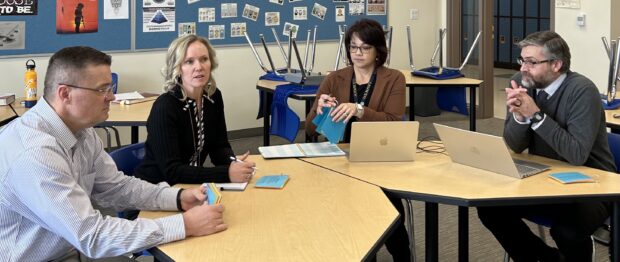
“You’re always a better teacher when you have a team,” Olsen said. “We fill in each other’s strengths and weaknesses.”
For schools that truly follow the PLC model – and that means aligning curriculum, looking at data, and giving teachers ample time to do both – it’s a game changer.
“It’s amazing what you can see happen in the classroom,” Olsen said. But she cautioned: “It’s not something that happens in one year. It is a process that never ends. We’re always making it better.”
At a math PLC meeting, two teachers new to the district discussed how helpful the time has been to them. Instead of stressing out and working before and after school to create new lesson plans and assignments, they’re automatically part of a team that helps them do just that every Monday.
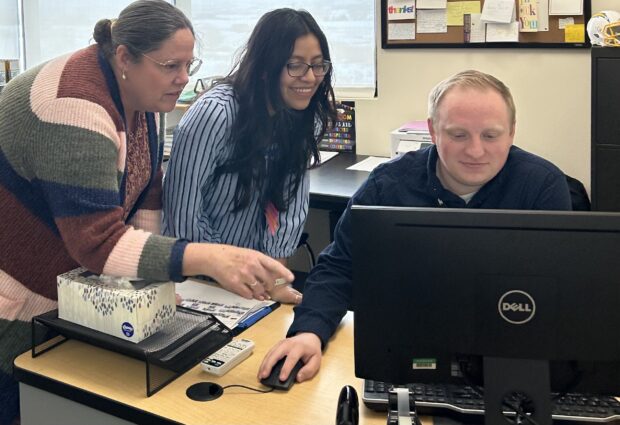
The time is helpful for veterans, as well.
Brian said she couldn’t imagine going back to the mundane Mondays.
“As a teacher, I think it really helps me balance my workload and I feel like it’s actually possible to do my job,” Brian said. “It’s still a juggle, but it’s a more healthy work-life balance than I’ve ever had.”
The Mondays are not a “magic bullet”
Woolstenhulme is proud of the unique Monday schedule, but said it came after years of teaching the concepts of PLC and student interventions.
“I’m very skeptical of any magic bullets when it comes to educational improvements,” he said. “It takes a sustained commitment to implementing change and the right principles before you ever see the benefits.”

